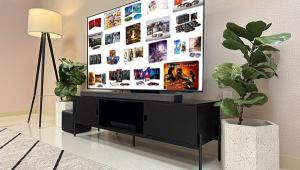Sony HCS-80 ChromaVue High-Contrast Home Theater Screen Measurements

The accompanying figure shows the color temperature with the Sony Cineza projector on a Studiotek 130 screen and, using the same calibration settings, on the ChromaVue. Note that the color temperature increases by 300K to 400K on the ChromaVue. This is largely because the screen appears to absorb additional red in the image, suggesting that its red reflective point is not precisely matched to the projector (or, more likely, to the specific lamp or filter in the projector). The Cineza projector is shy of red in the first place, which is obvious from the color temperature increase at higher light output (a characteristic of the projector based on our previous experience with other samples).
I was able to recapture about half of this difference by a recalibration of the projector, but not all of it. The result (not shown) was an increase of 100K to 200K with the ChromaVue over the result with the Studiotek. Also, the red, green, and blue color points changed with the ChromaVue, but the variations were relatively small.
Compared to the Studiotek, the ChromaVue's brightness fell off much more dramatically from the center of the image to the corners. Taking an average of the measured brightness at the four corners of the screen, the Studiotek's corner brightness was 69% of its center output; the ChromaVue's was 21.4%. The fact that this was not as visually obvious as I would have expected is accounted for in the adaptability of the human eye, not to mention that the eye does not respond linearly to brightness changes. The ChromaVue's center hot spot was clearly visible on full white fields, but not on normal program material.
Finally, I measured the peak contrast on the ChromaVue and Studiotek screens in the three lighting conditions, with the projector's auto iris on and the lamp at its Low setting. The results were consistent with my visual observations. My measurements don't show quite the 5x improvement in contrast claimed in Sony's press releases, but they do show an impressive numerical improvement of 3x to 4x, depending on the ambient light level.
(Note: for the measurements in the totally darkened room, I have added 0.001 foot-lambert to the video black measurement to account for the specified 0.001fL accuracy of my Minolta LS-100 light meter. Even in this worst-case situation, however, the darkened-room contrast results surprised me. They were considerably better than I measured on earlier samples of the projector.
Screen: Lights Out
ChromaVue: 5995
Studiotek130: 6150
Screen: Half Brightness
ChromaVue:1538
Studiotek 130: 524
Screen: Full Brightness
ChromaVue: 120
Studiotek 130: 32
You can see that the ChromaVue still maintains a reasonable peak contrast at half brightness (though nowhere near its Lights Out reading), while the Studiotek's is dramatically reduced. With the lights full on, you can see why neither screen looked all that impressive on dark scenes!
Put another way, the following table shows the increase in the video black level of each screen (referenced to the video black level in a totally darkened room).
Screen: Half Brightness
ChromaVue: x5.2
Studiotek 130: x17.4
Screen: Full Brightness
ChromaVue: x68
Studiotek 130: x303













































